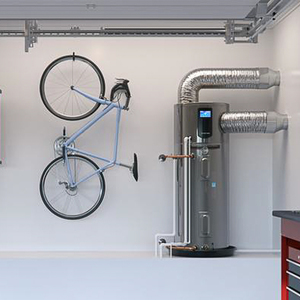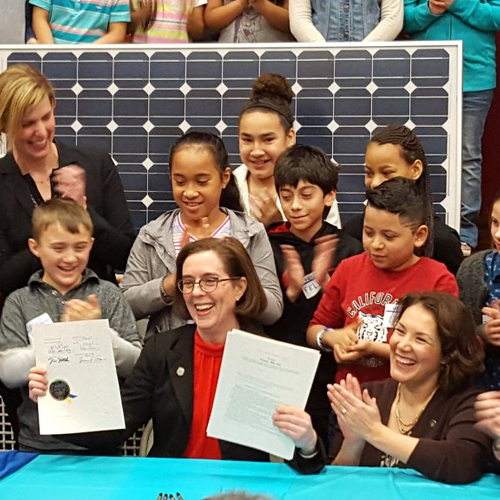
Clean space and water heating technologies such as heat pumps and solar thermal have the potential to save Californians more than $1,500 upon installation and hundreds of dollars on annual utility bills afterward. In particular, super-high-efficiency heat pump technology is key for the state to meet its clean energy and clean air goals, according to the first in-depth analysis of the economics and grid impacts of building decarbonization in California.
If a third of California’s buildings switched to clean electric space and water heating technology by 2030, heating emissions would fall by 7 million metric tons per year, according to the Synapse Energy Economics report commissioned by the Natural Resources Defense Council. That’s equivalent to cutting the annual emissions from 1.5 million cars — or avoiding the pollution from nearly four 500-megawatt gas power plants running around the clock.
“To achieve California clean and affordable energy goals, high-efficiency electric heat pumps need to become mainstream by 2030,” the report concludes. “This gives the state a dozen years to develop the market and make this heating technology affordable and accessible to all.”
Buildings account for about a quarter of California’s greenhouse gas emissions, and more than half of those come from the energy used for space and water heating. Californians are overwhelmingly dependent on fossil fuels for heat: Roughly 90% of furnaces and water heaters are fueled by gas or propane.
As the report shows, using today’s efficient electric technologies for heating homes, providing hot showers, and drying clothes can save many customers thousands of dollars over the life of these appliances, and can benefit everyone if supported with smart policies. The analysis demonstrates that clean heating powered by renewable energy can be a key driver to achieve clean energy and clean air goals, while also helping Californians afford their utility bills.
Heat pumps, which move heat rather than burning fuel to create heat, will be critical in this transition. These include heat pumps for space heating, which are already broadly adopted in commercial buildings, heat-pump water heaters, and heat-pump clothes dryers. Other technologies like solar thermal (which uses the sun to heat water) can also help reduce dependence on fossil fuels.
Meeting California’s new goal to become carbon-neutral by 2045 will require this shift to clean electric heat, a pathway that lacked policy attention until the recent passage of Senate Bill 1477 and Assembly Bill 3232. SB 1477 will expand the accessibility of clean heating technologies by promoting them in the market with incentives and training, while AB 3232 charges the California Energy Commission with assessing how to reduce emissions from the state’s building stock by 40% below 1990 levels by 2030.
Making the economics work
Because they are so much more efficient than gas-powered heating equipment, heat pumps save significant amounts of energy and emissions. The economics of heat pumps for individual customers is a more complex question and varies widely depending on the building, occupants’ usage, their utility rates, and whether a building has solar panels.
In new homes, highly efficient electric space and water heating costs less than conventional gas equipment by around $1,500 largely due to the avoided gas connection and plumbing costs. And depending on how large the rooftop photovoltaic (PV) system generating electricity is, and local utility rates, annual utility bills vary from several hundred dollars lower to slightly higher than with gas equipment.
Greater savings are achieved by using time-varying electric rates and by maximizing cost-effective PV panels to supply the larger electric load.
In existing buildings, the upfront costs for clean heating retrofits also vary widely, from lower than gas when replacing both a furnace and air-conditioner with a single heat pump, to higher — particularly when electrical upgrades are needed. Utility bills vary on a spectrum from $300 higher to $800 lower annually, with the lower bills achieved when pairing electrification with some basic energy efficiency upgrades, time-varying electric rate designs, and by using solar PV to supply the larger electric load.
But electric heating also has other benefits, such as increased comfort from quieter equipment and providing a more stable temperature. Electric equipment also avoids the inherent safety hazards and indoor air pollution associated with gas combustion.
Grid benefits
Widespread adoption of electric heat could potentially increase California’s overall electricity demand by up to 19%, according to the report, while cutting gas demand by a third. However, this may not require significant additional generation resources if new electric heating equipment is energy-efficient and flexible.
Efficient equipment minimizes incremental demand during grid peak events. Flexible equipment can shift electricity use from peak to off-peak hours — by pre-heating water tanks when demand is low or renewable energy is abundant, for example — helping use the existing grid resources more efficiently and ultimately cutting overall system costs.
As the authors write, “Buildings that can use electric heat to store clean, renewable energy instead of burning gas on site would be assets on a renewable grid.”
Policy pathways
The report highlights four policy areas for the California government, local jurisdictions, and utilities to jump-start the market for cleaner heating technologies and help make it accessible and affordable to all Californians:
- Raise awareness and educate: Consumers, policymakers, product distributors, and building contractors need to be familiar with the availability and benefits of electric heating, and need to be familiar with how to install the necessary equipment.
- Set targets and develop plans: The clean heating market needs certainty and stable investment in order to expand. California’s two recently passed laws are an important first step. More will be needed, particularly to help owners of existing buildings switch to clean heating.
- Remove regulatory and market barriers: Incentives for distributors and retailers, along with financing and utility rate designs for electric heating, are among the ways the state can address cost and product availability hurdles.
- Transform the market: Revising building codes to encourage clean heating technologies in new buildings, investing in further research, and encouraging concurrent energy efficiency upgrades can lend additional support to clean heat technologies.
These steps may seem challenging, but they’re essential for California to transition to renewable energy, clean up the air, and help make housing more affordable. The recent dire warnings from the Intergovernmental Panel on Climate Change, Global Warming of 1.5°C, make California’s leadership all the more important. Let’s get going!
Pierre Delforge is senior scientist, building decarbonization, climate and clean energy program, at the Natural Resource Defense Council. This post was originally published at the NRDC Expert Blog.
Weekly Newsletter
Get building science and energy efficiency advice, plus special offers, in your inbox.















0 Comments
Log in or create an account to post a comment.
Sign up Log in